Related Research Articles
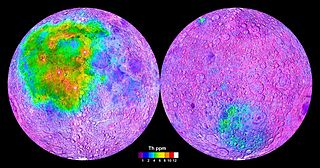
KREEP, an acronym built from the letters K, REE and P, is a geochemical component of some lunar impact breccia and basaltic rocks. Its most significant feature is somewhat enhanced concentration of a majority of so-called "incompatible" elements and the heat-producing elements, namely radioactive uranium, thorium, and potassium.
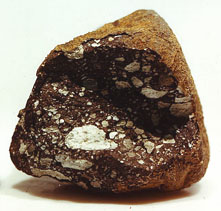
A lunar meteorite is a meteorite that is known to have originated on the Moon. A meteorite hitting the Moon is normally classified as a transient lunar phenomenon.

Impactite is rock created or modified by one or more impacts of a meteorite. Impactites are considered metamorphic rock, because their source materials were modified by the heat and pressure of the impact. On Earth, impactites are made primarily of modified terrestrial material, sometimes with pieces of the original meteorite.
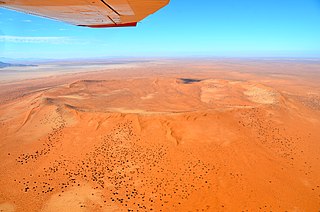
Roter Kamm is a meteorite crater, located in the Sperrgebiet, within the Namibian section of the Namib Desert, approximately 80 kilometres (50 mi) north of Oranjemund and 12 kilometres (7.5 mi) southwest of Aurus Mountain in the ǁKaras Region. The crater is 2.5 kilometres (1.6 mi) in diameter and is 130 metres (430 ft) deep. The age is estimated at 4.81 ± 0.5 Ma, placing it in the Pliocene. The crater is exposed at the surface, but its original floor is covered by sand deposits at least 100 metres (330 ft) thick.

Sayh al Uhaymir 169 is a 206 grams lunar meteorite found in the Sayh al Uhaymir region of the Sultanate of Oman in January 2002.

The geology of the Moon is quite different from that of Earth. The Moon lacks a true atmosphere, which eliminates erosion due to weather. It does not have any known form of plate tectonics, it has a lower gravity, and because of its small size, it cooled faster. The complex geomorphology of the lunar surface has been formed by a combination of processes, especially impact cratering and volcanism. The Moon is a differentiated body, with a crust, mantle, and core.
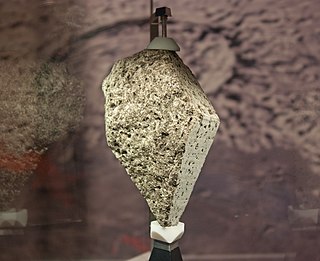
Moon rock or lunar rock refers to rock that is found on the Earth's Moon. This includes lunar material collected during the course of human exploration of the Moon, and rock that has been ejected naturally from the Moon's surface and landed on the Earth as meteorites.

Lunar soil is the fine fraction of the regolith found on the surface of the Moon. Its properties can differ significantly from those of terrestrial dirt. The physical properties of lunar soil are primarily the result of mechanical disintegration of basaltic and anorthositic rock, caused by continual meteoric impacts and bombardment by solar and interstellar charged atomic particles over years. The process is largely one of mechanical weathering in which the particles are ground to progressively finer size over time. This situation contrasts fundamentally to terrestrial dirt formation, mediated by the presence of molecular oxygen (O2), humidity, atmospheric wind, and a robust array of contributing biological processes.

The Lunar Magma Ocean (LMO) is the layer of molten rock that is theorized to have been present on the surface of the Moon. The Lunar Magma Ocean was likely present on the Moon from the time of the Moon's formation to tens or hundreds of millions years after that time. It is a thermodynamic consequence of the Moon's relatively rapid formation in the aftermath of a giant impact between the proto-Earth and another planetary body. As the Moon accreted from the debris from the giant impact, gravitational potential energy was converted to thermal energy. Due to the rapid accretion of the Moon, thermal energy was trapped since it did not have sufficient time to thermally radiate away energy through the lunar surface. The subsequent thermochemical evolution of the Lunar Magma Ocean explains the Moon's largely anorthositic crust, europium anomaly, and KREEP material.

An impact structure is a generally circular or craterlike geologic structure of deformed bedrock or sediment produced by impact on a planetary surface, whatever the stage of erosion of the structure. In contrast, an impact crater is the surface expression of an impact structure. In many cases, on Earth, the impact crater has been destroyed by erosion, leaving only the deformed rock or sediment of the impact structure behind. This is the fate of almost all old impact craters on Earth, unlike the ancient pristine craters preserved on the Moon and other geologically inactive rocky bodies with old surfaces in the Solar System. Impact structure is synonymous with the less commonly used term astrobleme meaning "star wound".

David Stewart McKay was Chief Scientist for astrobiology at the Johnson Space Center. During the Apollo program, McKay provided geology training to the first men to walk on the Moon in the late 1960s. McKay was the first author of a scientific paper postulating past life on Mars on the basis of evidence in Martian meteorite ALH 84001, which had been found in Antarctica. This paper has become one of the most heavily cited papers in planetary science. The NASA Astrobiology Institute was founded partially as a result of community interest in this paper and related topics. He was a native of Titusville, Pennsylvania.

Traces of Catastrophe: A Handbook of Shock-Metamorphic Effects in Terrestrial Meteorite Impact Structures is a book written by Bevan M. French of the Smithsonian Institution. It is a comprehensive technical reference on the science of impact craters. It was published in 1998 by the Lunar and Planetary Institute (LPI), which is part of the Universities Space Research Association (USRA). It was originally available in hard copy from LPI, but is now only available as a portable document format (PDF) e-book free download.
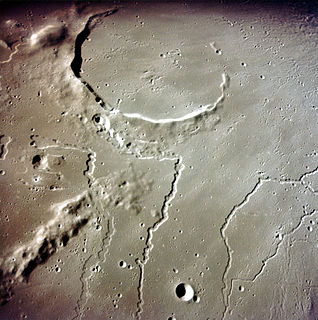
Planetary science or, more rarely, planetology, is the scientific study of planets, moons, and planetary systems and the processes that form them. It studies objects ranging in size from micrometeoroids to gas giants, aiming to determine their composition, dynamics, formation, interrelations and history. It is a strongly interdisciplinary field, originally growing from astronomy and earth science, but which now incorporates many disciplines, including planetary geology, cosmochemistry, atmospheric science, oceanography, hydrology, theoretical planetary science, glaciology, and exoplanetology. Allied disciplines include space physics, when concerned with the effects of the Sun on the bodies of the Solar System, and astrobiology.
This is a glossary of terms used in meteoritics, the science of meteorites.

Northwest Africa 7034 is a Martian meteorite believed to be the second oldest yet discovered. It is estimated to be two billion years old and contains the most water of any Martian meteorite found on Earth. Although it is from Mars it does not fit into any of the three SNC meteorite categories, and forms a new Martian meteorite group named "Martian ". Nicknamed "Black Beauty", it was purchased in Morocco and a slice of it was donated to the University of New Mexico by its American owner.

Allan Hills A81005 or ALH A81005 was the first lunar meteorite found on Earth. It was found in 1982 in the Allan Hills at the end of the Transantarctic Mountains, during a meteorite gathering expedition (ANSMET).

Luna 27 is a planned lunar lander mission by the Roscosmos with collaboration by the European Space Agency (ESA) to send a lander to the South Pole–Aitken basin, an area on the far side of the Moon. Its objective will be to detect and characterise lunar polar volatiles. The mission is a continuation of the Luna-Glob programme.

Lunar Sample 14321, better known as "Big Bertha", is a lunar sample containing an embedded Earth-origin meteorite collected on the 1971 Apollo 14 mission. It was found in the Fra Mauro region of the Moon. Big Bertha is the first discovered meteorite from Earth, and the embedded meteorite portion is the oldest known Earth rock. At 8.998 kg (19.837 lb), this breccia rock is the third largest Moon sample returned during the Apollo program, behind Big Muley and Great Scott.

Katherine Helen Joy is a Reader in Earth Sciences at the University of Manchester. Joy has studied lunar samples from the Apollo program as part of her research on meteorites and lunar science.
References
- 1 2 3 4 5 Meteoritical Bulletin Database: Yamato 791197
- ↑ Cassidy, William A. (2003). Meteorites, Ice, and Antarctica. Cambridge University Press. p. 186.
- ↑ Korotev, Randy L. "Lunar Meteorite: Yamato 791197". Washington University in St. Louis, Department of Earth and Planetary Sciences. Retrieved 2011-11-15.
- ↑ Ostertag, R.; et al. (1985). "Lunar meteorite Yamato 791197: a weakly shocked regolith breccia from the far side of the Moon". Lunar and Planetary Science. XVI/3: 635–636.